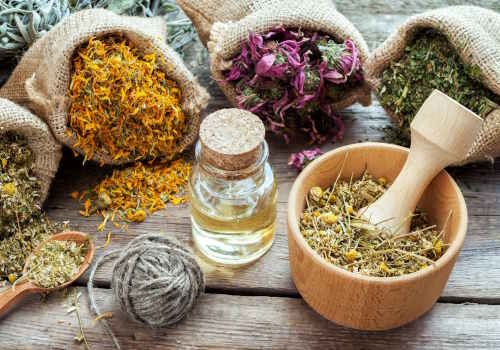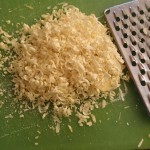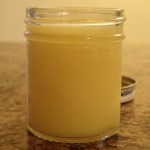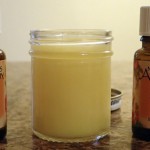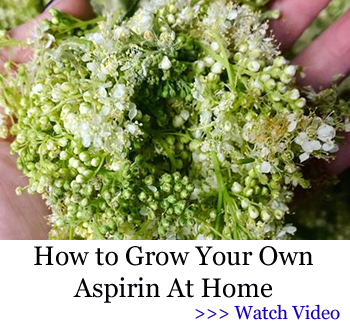Why Apothecary Guarantees Your Success in Making Herbal Remedies…
The world of plants is a powerful one. There are a wealth of components in plants that serve to protect them at various stages of development, as there are so many forces at play including weather, predators (including us) and soil quality. When we consume these plant constituents in various forms, we can also reap the benefits – but learning how to prepare these plants properly is crucial. This is where homemade tinctures and tonics come in.
Homemade tinctures and tonics are actually not as complicated as you might think and when you learn the common methods to formulate them, the possibilities become endless.
Learning about herbal medicine doesn’t have to be complicated.
When I got started years ago I didn’t know where to start. And it was frustrating. I tried a few books — but something was missing.
All I wanted was someone to show me the basics so I could get started the right way… Like an “Easy Button.” I was a busy mom and had no time or money to waste on hours and hours of study.
Today there’s too much conflicting free information online, it’s overwhelming! Online courses, certifications, hundreds of books, social media… Who has time for that?
And worse yet — it’s hard to know who you can trust.
After helping tens of thousands of budding home herbalists over the last 20 years, I created the perfect place to begin.
Apothecary EMPOWERS YOU to successfully make your own herbal medicines at home, quickly and easily, and it’s FUN!
Our Simple Herbal Learning System guides you every step of the way.
Not only will you stock your kitchen with essential herbs and supplies, you’ll also learn how to make the 15 Core Herbal Remedies.
From teas and tinctures to syrups and salves, your kitchen will be transformed into a natural pharmacy that you and your family can rely on for years.
There are several ways you can extract the benefits from herbs and other plants. These are:
Infusion: An infusion is when you steep plants in water or oil to glean their beneficial properties. One of the most common infusions is tea, which most of us are accustomed to drinking.
# Decoction: This is boiling an herb or vegetable in water, so the water then contains the soluble constituents of the plant being boiled. This is a great method for hardier plants that won’t ‘give up the goods’ with gentler methods – a good example would be chaga or reishi mushrooms.
# Tincture: A solution of alcohol or alcohol and water, along with the plant that you’re using for medicinal benefits. Tinctures usually take longer to make, anywhere from a couple of weeks to a couple of months to fully saturate the liquid with the plant medicine (think of vanilla extract, for example).
# Maceration: Softening by soaking in a liquid. Maceration is generally used for very delicate plants and the liquid is usually cold or barely heated. Often, macerations use oil as the liquid.
Choosing Herbs + Vegetables
The type of herb you use will depend on what your herbal medicine is for – it may be to support the immune system, calm the nervous system, ease digestion or reduce inflammation. For a few recommended herbs for healing, you can check out our Guide to Culinary Adaptogens or our DIY Elixir Guide.
How To Make Infusions
A good general rule of thumb is 1 teaspoon of herb to 1 cup of water – of course, this may vary depending on your personal tastes, and how strong or weak you prefer your infusion to be.
Some great herbs for infusions are:
- Chamomile: Calming and great for digestion.
- Peppermint: Helps to relax the muscles of the digestive tract and reduce spasms.
- Cinnamon: Great for balancing blood sugar.
- Ginger: Anti-inflammatory, immune-boosting and great for nausea.
- Licorice: A great digestive aid, and it’s anti-microbial and anti-bacterial.
- Turmeric: Strongly anti-inflammatory and rich in anti-cancer properties.
Learn more about tea blends here. And don’t forget – you can also use tea infusions in cooking and baking!
How To Make Decoctions
Use about 1 teaspoon of herbs and one cup of cold water. Put your herbs and water into a pot, then bring to a boil. Lower the heat, cover and let it simmer from 20 to 45 minutes, depending on how hardy the plant is. Strain the liquid, then drink or use it in your culinary recipes.
How To Make Tinctures
Tinctures are surprisingly easy to make! We have a free class where we demonstrate how to make a tinctures – check it out here.
What you need:
- Herb of choice
- 40% vodka (in glass bottle)
- 1 glass jar
- Parchment paper
- Masking tape for labelling
- Cheesecloth or nut milk bag
How to Make Tinctures:
- Fill up glass jar with herb halfway.
- Add vodka so that level of the liquid is at least two inches above the herb. Note: If you are using dried herbs, you might have to add more vodka at a later time.
- Place parchment paper between the lid and jar. (This is done to prevent the rubber seal from dissolving.)
- Seal jar tightly.
- Label jar with date, percentage alcohol, herbs, and method used.
- Shake two times per day for one month.
- After a month squeeze out the menstrum (the resulting liquid) using cheesecloth or a nut milk bag.
How To Make Macerations
Many macerations are made using oils to gently extract the plant power. Put your herbs and oil into a small jar. You can let them infuse anywhere from an hour to a few weeks. For an example of how you can macerate for beauty care, check out this skin-soothing salve.
More Herbal Medicine Tips
- Use the fresh herbs. This will produce the most powerful tincture and tonics. If your herbs don’t have a scent, that’s not going to change once you make your herbal medicine.
- Cut the herbs into small pieces. This allows for a greater surface area so the plant compounds can infuse into the liquid.
- Label your jars. Label your herbal medicines with the date and what’s inside them. That way there will be no confusion! (You may think you’ll remember what everything is. You won’t. Trust us!)
- Start slowly. This is powerful plant medicine. These tinctures and tonics are meant to be taken in small amounts. With a tincture, you may only need a few drops.
Interesting in Learning More About Homemade Medicine?
Herbal medicine has a lot more function in everyday use than most of us realize. Start creating your own herbal remedies with our self-paced online course, Everyday Herbal.
Antiseptic Ointment
Ingredients
- 1-1/2 ounces beeswax, grated
- 1 Cup Coconut oil
- 1/4 teaspoon vitamin E oil
- 1/2 teaspoon tea tree oil
- 20 drops lavender essential oil
- 10 drops lemon essential oil
Ingredient Properties
- Tea tree oil: antibiotic, anti-fungal, antiviral, antibacterial
- Lavender: analgesic (pain relief), antibiotic, anti-fungal, antiviral, antibacterial
- Lemon: antibiotic, antifungal, antiviral, antibacterial
- Coconut oil: anti-inflammatory properties
- Vitamin E: Skin healing vitamin
Step 1. Grate 1-1/2 ounces of beeswax using a cheese grater or just slice thinly with a knife.
Step 2. Add 1 cup coconut oil and the grated beeswax to a pot.
Step 3. Heat the coconut oil and beeswax over a low heat or double boiler until in liquid form. Once in liquid form remove from heat and add the tea tree oil, vitamin E, and essential oils and stir briefly.
Step 4. Pour mixture into sterilized jars. You can use baby food jars or mason jars. Let cool on counter. To sterilize jars either boil for 10 minutes or run through your dishwasher.
Step 5. Store in a cool, dark place. Use as needed on any cuts, scrapes and abrasions. Lasts for approximately 4 years shelf life.
The Medicine Maker’s Cookbook guides you through building your home apothecary. It includes simple access to every remedy video via your smartphone. You also have the option to view the videos through the website. We show you exactly what to do and when to do it so you never get overwhelmed. You never have to worry about being unsafe or making a mistake.
Cayenne Salve for Herbal Pain Relief
The health benefits of cayenne are truly astounding. An herbal pain reliever, cayenne has heart-protective qualities and can boost the immune system. It will even stop bleeding from a cut or wound!
This recipe is a super simple salve that can be made up very quickly and bring big-time herbal pain relief.
What you’ll need…
1/2 cup olive oil
2 tablespoons cayenne powder (or 15 grams)
1/2 ounce beeswax
Begin by combining the cayenne and olive oil in a double boiler or a pan on very low heat. Heat the oil and cayenne until it is warm, turn off the heat, and let it sit (warmly) for about 20 minutes, then turn the heat on again. I repeat this process for at least one hour to a couple of hours. You could do it for 24 hours if desired.
Once the cayenne and olive oil have been infused, strain off the powder through a cheesecloth. Reserve the infused oil.
Heat the beeswax until it is melted. Stir in the infused oil until the beeswax and oil have been thoroughly melted together and combined.
Immediately pour this mixture into jars or tins. Let it cool and then label it. Yield: About 4 ounces
Using Your Cayenne Salve This cayenne salve can be used on aches and pains, from sore muscles and joints to bruises and even nerve pain. It is best for closed wounds and may sting a bit on open wounds. Even on closed skin you may feel a bit of burning or heat in the area where it is used. It should be applied externally only and used within 6 months for the best results. If using it for arthritic pain, it may take up to a week or two to see results. In this case you want to use it daily to decrease chronic pain.
Calendula is a big player when it comes to skin healing properties. Calendula is a hardy annual that should be grown in every garden. If you haven’t put any calendula in your garden this season, grab a package of seed at the grocery store this week and put some in the rows between your vegetable plants. Bees love calendula and once you’ve used it, you’ll never want to be without it again.
Calendula blossoms are pain relieving, and promote the healing of cuts and wounds. Calendula reduces inflammation, stops bleeding, aids in the rebuilding of tissue, and is anti-septic, anti-microbial, and anti-fungal, ensuring that the wound heals cleanly. Calendula can be combined with lavender and tea tree essential oils to heal burns, cuts, scrapes, and rashes.
To increase the effectiveness of your first aid ointment, adding another herb to increase the effectiveness of Calendula is helpful. Comfrey adds more anti-septic and anti-microbial virtue to calendula, as well as speeding healing by increasing the rate of cell proliferation. Plantain, promotes the drawing of poison from the body, as well as reducing inflammation and increasing the range of anti-microbial effects of both comfrey and calendula. The ruby red infused oil of St. John’s Wort helps cleanse the blood and rebuild nerves after trauma, while also promoting the healing of cuts and wounds.
This recipe starts with dried Calendula flowers. You can either purchase them dried or dry them yourself.
I’ve also made salves with only pure, organic olive oil, and they turn out wonderful. Feel free to use a blend of different oils if you would like. Virgin coconut oil and sweet almond oil are known for being great for the skin so I often add a bit of those in, too.
Calendula Salve
Ingredients
Dried Calendula flowers
Oil for infusing the flowers (olive, coconut, and sweet almond oil make a good blend)
Beeswax (one ounce per one cup of infused oil, more or less)
Essential oils (10-20 drops per cup of infused oil, optional)
Directions
The first step is to make infused Calendula oil. There are many ways to do this, here is more information: How to Make Infused Herbal Oils.
Strain the infused oil using a cheesecloth and strainer, squeezing out as much of the oil as possible.
Put the infused oil into a double boiler, which can be as simple as a stainless steel bowl that fits over a pot with an inch or two of water in it. Bring that water to a simmer to gently heat the oil.
Add the beeswax, and stir occasionally until it has completely dissolved.
Add essential oils if using, and stir to combine.
Carefully pour the hot salve into tins or jars.
Let cool completely before use.
How to make a hot oil extraction
You will need a full day to infuse the oil using a low heat. I like to do this in my smaller crock pot.
Put 3 to 4 cups of fresh, chopped herbs in a heat resistant sauce pan or use your crock pot on low. Use a combination of calendula blossoms and a mixture other herbs available in your area. Use the chart above to help you decide which ones are best for your circumstances.
Cover the herbs with oil so that they are just barely covered.
Leave the pan uncovered, and slowly raise the temperature of the oil until the mixture just barely begins to bubble. Having the pot uncovered allows the moisture in the fresh herbs to evaporate off. Simmer gently, stirring frequently, until the herbs are crisp. If you use your crock pot on low to do this, your herbs will not cook too fast. This process should take 4 to 5 hours or up to a full day to complete.
Cool, strain and you are ready to use this to make your own first aid ointment.
For my personal first-aid ointment I make my oil with 1 cup of calendula blossoms, 1 cup of finely chopped comfrey, 1 cup of St. Johns Wort blossoms, and 1 cup of finely chopped plantain leaves to 4 cups of olive oil.
Making your salve or first-aid ointment
Once you have your herb infused oil ready, for every 4 ounces of herb infused oil,
add ½ ounce of cocoa butter,
1/4 oz. of bees wax, melted,
½ tsp. of vitamin E oil as a preservative.
Add the 15 drops of the essential oils of your choice. I like 5 drops of lavender, 5 drops of tea tree, and 5 drops of myrrh. This increases the anti-fungal, anti-biotic, and skin soothing properties of your salve.
Books can be your best pre-collapse investment.
Carnivore’s Bible (is a wellknown meat processor providing custom meat processing services locally andacross the state of Montana and more. Whether your needs are for domestic meator wild game meat processing)
The Lost Book of Remedies PDF ( contains a series of medicinal andherbal recipes to make home made remedies from medicinal plants and herbs.Chromic diseases and maladies can be overcome by taking the remediesoutlined in this book. The writer claims that his grandfather was taughtherbalism and healing whilst in active service during world war twoand that he has treated many soldiers with his home made cures. )
Easy Cellar(Info about building and managing your root cellar, plus printable plans. The book on building and using root cellars – The Complete Root Cellar Book.)
The Lost Ways (Learn the long forgotten secrets that helped our forefathers survive famines,wars,economic crisis and anything else life threw at them)
LOST WAYS 2 ( Wordof the day: Prepare! And do it the old fashion way, like our fore-fathers did it and succeed longbefore us,because what lies ahead of us will require all the help we can get. Watch this video and learn the 3 skills that ensured our ancestors survival in hard times offamine and war.)
SOURCE : https://www.prepperfortress.com/why-apothecary-guarantees-your-success-in-making-herbal-remedies/
Anyone can join.
Anyone can contribute.
Anyone can become informed about their world.
"United We Stand" Click Here To Create Your Personal Citizen Journalist Account Today, Be Sure To Invite Your Friends.
Lion’s Mane Mushroom Nootropic
Mushrooms are having a moment. One fabulous fungus in particular, lion’s mane, may help improve memory, depression and anxiety symptoms. They are also an excellent source of nutrients that show promise as a therapy for dementia, and other neurodegenerative diseases. If you’re living with anxiety or depression, you may be curious about all the therapy options out there — including the natural ones.Our Lion’s Mane WHOLE MIND Nootropic Blend has been formulated to utilize the potency of Lion’s mane but also include the benefits of four other Highly Beneficial Mushrooms. Synergistically, they work together to Build your health through improving cognitive function and immunity regardless of your age. Our Nootropic not only improves your Cognitive Function and Activates your Immune System, But it benefits growth of Essential Gut Flora, further enhancing your Vitality.
Our Formula includes: Lion’s Mane Mushrooms which Increase Brain Power through nerve growth, lessen anxiety, reduce depression, and improve concentration. Its an excellent adaptogen, promotes sleep and improves immunity.
Shiitake Mushrooms which Fight cancer cells and infectious disease, boost the immune system, promotes brain function, and serves as a source of B vitamins.
Maitake Mushrooms which regulate blood sugar levels of diabetics, reduce hypertension and boosts the immune system.
Reishi Mushrooms which Fight inflammation, liver disease, fatigue, tumor growth and cancer. They Improve skin disorders and soothes digestive problems, stomach ulcers and leaky gut syndrome.
Chaga Mushrooms which have anti-aging effects, boost immune function, improve stamina and athletic performance, even act as a natural aphrodisiac, fighting diabetes and improving liver function.
Try Our Lion’s Mane WHOLE MIND Nootropic Blend 60 Capsules Today. Be 100% Satisfied or Receive a Full Money Back Guarantee. Order Yours Today by Following This Link.




